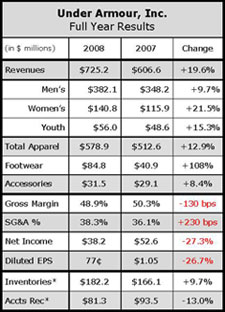What a difference a year makes. A year ago at this time, Under Armour was flying high as apparel sales were routinely up in strong double-digits again and the company was prepping for its long-hyped launch into non-cleated footwear with the debut of the performance training shoes. Fast forward a year and perhaps the best growth story of the last ten years in the sporting goods business is starting to look a bit more like a reflection of the economy.
Stymied by lower-than-anticipated at-once orders and higher-than-anticipated cancellations and returns, Under Armour ended the 2008 year on a down note as profits plummeted and apparel revenues took their first negative turn in the fourth quarter.
Total company revenues rose 2.5% to $179.3 million in the fourth quarter from $174.8 million in the year-ago period. The apparel business contracted a bit as growth in the womens and youth business was offset by declines in the mens business. A 47.4% increase in the companys direct-to-consumer business helped limit the declines.
Total apparel revenues were down 0.2% to $152.4 million in the fourth quarter. Sales in the mens business declined 2.6% to $103 million, while womens apparel gained 7.4% to $35.7 million and youth apparel dipped 0.1% to $13.76 million. Footwear revenues jumped 35.7% to $9.2 million off a small base and accessories grew 2.6% to $9.3 million.

As forecast earlier, Under Armour reported that fourth quarter earnings fell 50.9% to $8.32 million, or 17 cents a share, from $16.9 million, or 34 cents, in the 2007 fourth quarter.
Gross margins eroded 130 basis points to 50.7% from 52.0%, partly due to a higher proportion of lower gross margin footwear sales, but that was offset by a higher percentage of sales coming from UAs direct-to-customer business, which includes four specialty stores, 25 outlet stores and a Web business. Selling, general and administrative expenses increased 190 basis points to 37.9% of sales from 35.8% largely as a result of the continued expansion of the direct-to-consumer channel.
The Web business was said to have the highest margins, followed by the specialty stores with outlet margins last. Management noted the outlet channel had gross margins that were predictably higher than the wholesale business. Management felt the higher SG&A costs associated with the direct business offset the margin gains and brought the overall operating margins of the direct business in line with the wholesale business.
The company is expected to open between five and ten new outlet stores in 2009, but will not open any specialty stores this year.
The outlet store strategy has certainly helped the company's inventory situation from getting any further out of hand. Inventories are roughly flat to last year when excluding the footwear inventory brought in to support the running launch. However, inventories last year were up roughly 105% versus the prior year-end, so the year started with a lot of goods in the pipeline.
The year-ago inventory position helped Under Armour reduce its 2008 inventory purchases by about $50 million, which has helped the balance sheet quite a bit and boosted the companys cash position 150% to $102 million. UA was also able to flex its strong balance sheet position to secure a new three-year revolving credit line of $180 million, replacing the previous $100 million revolver.
For some, the company never recovered from its over-spend on marketing in the first half last year to support the performance training launch. The company planned to spend 12% to 13% of sales on marketing in 2008 and ended up spending 13.1% of sales. UA plans to again spend 12% to 13% on marketing in 2009, heavily weighted in the first half to support the running footwear launch. The running footwear opportunity is much bigger than the trainer business, but the company is also launching a new initiative in perhaps one of the tightest retail markets in 30 years.












